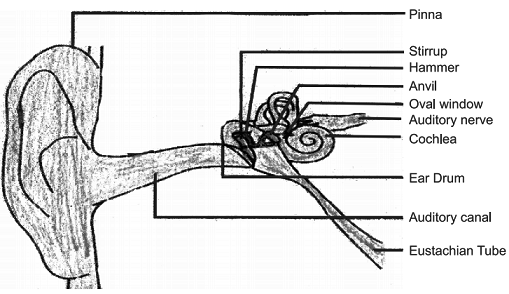Structure of Human Ear
• The ear consists of three parts : outer ear, middle ear and inner ear.
• The ears are the sense organs which help us in hearing sound.
• The outer ear is called pinna. It collects the sound from surroundings.
• This sound passes through the auditory canal.
• At the end of auditory canal, is a thin elastic membrane called ear drum or tympanic membrane.
• The middle ear contains of three bones : hammer, anvil and stirrup linked with one another. Free end of hammer touches ear drum and that of stirrup linked with membrane of oval window of inner ear.
• The lower part of middle ear has a narrow ‘Eustachian tube’.
• The inner ear has a coiled tube called cochlea, which is connected with oval window. Cochlea is filled with a liquid containing nerve cells. Other side of cochlea is connected to auditory nerve which goes to brain.

Working :
• When compression of sound wave strikes the ear drum, the pressure on the outside of ear drum increases and pushes the ear drum inwards.
While during rarefaction ear drum moves outwards. Thus, ear drum starts vibrating back and forth.
• These vibrations are increased by three bones and middle ear transmits these amplified pressure variations received from sound waves to inner ear.
• In the inner ear the pressure variations are turned into electric signals by the cochlea.
• These electric signals are sent to the brain via auditory nerve and the brain interprets them as sound.